新概念英语1公开课 Unit1 Excuse me!
新概念英语第一册第1课Lesson1课文单词知识点
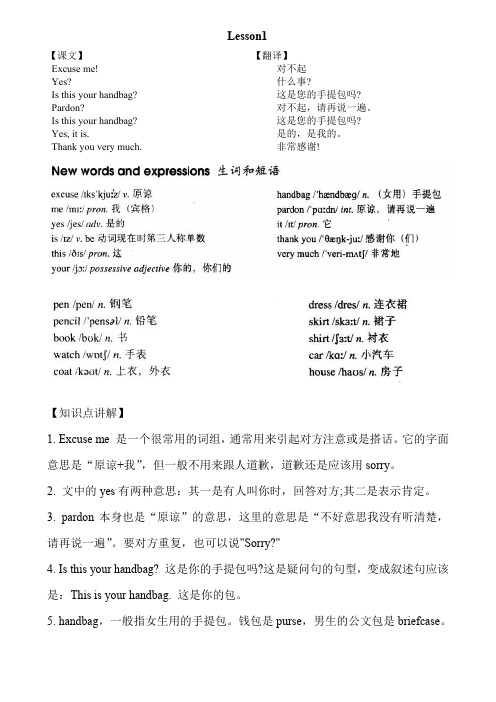
【知识点讲解】
1. Excuse me 是一个很常用的词组,通常用来引起对方注意或是搭话。
它的字面意思是“原谅+我”,但一般不用来跟人道歉,道歉还是应该用sorry 。
2. 文中的yes 有两种意思:其一是有人叫你时,回答对方;其二是表示肯定。
3. pardon 本身也是“原谅”的意思,这里的意思是“不好意思我没有听清楚,请再说一遍”。
要对方重复,也可以说"Sorry?"
4. Is this your handbag? 这是你的手提包吗?这是疑问句的句型,变成叙述句应该是:This is your handbag. 这是你的包。
5. handbag ,一般指女生用的手提包。
钱包是purse ,男生的公文包是briefcase 。
Lesson1
【课文】
Excuse me!
Yes?
Is this your handbag?
Pardon?
Is this your handbag?
Yes, it is.
Thank you very much. 【翻译】 对不起 什么事? 这是您的手提包吗? 对不起,请再说一遍。
这是您的手提包吗? 是的,是我的。
非常感谢!。
Lesson1Excuseme(课件)新概念英语第一册
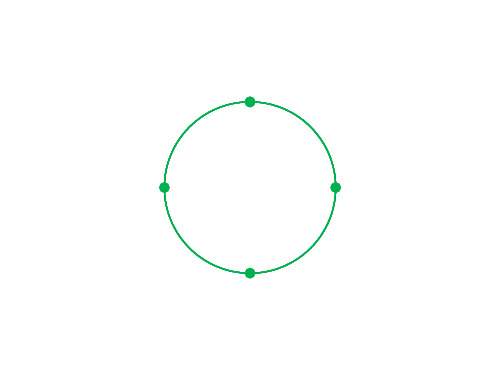
1. Pardon? =I beg your pardon?
请再说一遍。
2. Thank you very much.
=Thanks a lot. 非常感谢。
3. Yes?
什么事?
-Is this your handbag? 这是你的手提包吗?
-Yes, it is.
是的。
-Is this your pen?
(4)向某人借东西
Excuse me. Can I borrow your pen?
1、Excuse me.
对不起,打扰了。
(5)需要从别人身边挤过或让别人给自己让路
Excuse me. Could you make some room for me?
(6)在宴会或会议中途离开时 Excuse me. May I leave for a little while?
( B )2.
? Yes, it is.
A.This is your handbag
B. Is this your handbag
C. This’s your handbag
( A )3.A: Is this your book?
B:
?
A: Is this your book?
A. Pardon B. Excuse me C. Yes
possessive adjective 你的,你们的
n. (女用)手提包
int.原谅,请再说一遍
pron. 它
thank you Thank you.
/5WANk-ju:/
very much
/5verI-mQtF/
Thank you very much.
感谢你(们) 非常地
新概念第一册Lesson 1 Excuse me讲义

新概念第一册Lesson 1 Excuse me一、单词精讲excuse [iks’kju:z]v.原谅【用法】excuse me 意为:“对不起”1.想与陌生人交谈,引起对方的注意(如问路、见前方围一群人好奇的打听情况等)。
例如:Excuse me, where is the post office?2.在某个聚会中突然中途要离开一会(如需要接电话)。
例如:Excuse me, may I answer the phone?3.从别人面前经过,并可能给对方造成不便(如春运期间在火车上人群中穿梭)。
例如:Excuse me, could you leave me some room?4.对有失礼仪的行为表示抱歉(如打嗝、打喷嚏等)me[mi:]pron.我(宾格)【用法】宾格用在动词、介词之后。
He asked me to go to school with him.他邀请我和他一起去学校。
【拓展】I 表示主格,译为我,放在句首。
例如:I am a student.my我的,形容词性物主代词,不能单独使用,后面必须跟名词。
例如:This is my pen.mine 我的,名词性物主代词,相当于形物代+名词例。
如:This pen is mine. = This is my pen.yes [jes]adv.好,对[词性]它主要用作副词,表示“是,好,对”等肯定的回答。
例如:“Are you astudent?” “Yes, I am.”(“你是一名学生吗?”“是的,我是。
”)[词义扩展]在口语中,“yes”还可以用来表示同意、赞成或回应召唤等。
例如,当有人说“Let's go to the park.”(咱们去公园吧。
)你可以回答“Yes.”表示同意这个提议。
[常见用法搭配]“yes”常常单独使用,作为对一般疑问句的简短回答。
例如:“Do you like apples?” “Yes.”(“你喜欢苹果吗?”“是的。
新概念1 lesson1
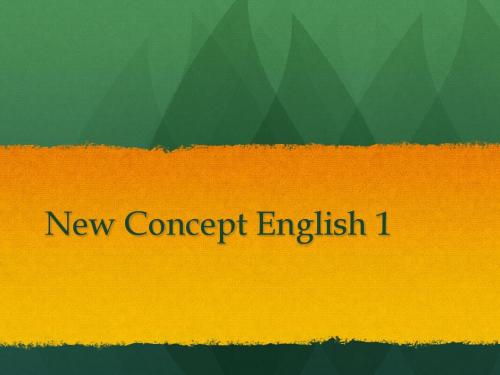
Lesson 1: Excuse me!
Excuse me
“抱歉”
sorry
引起注意 的场合
对发生过的事情 表达歉意(抱歉 的含义较重)
Lesson 1: Excuse me!
Vocabulary me 我(宾格:做宾语的“我”) “主语+谓语+宾语”结构中,处在宾语位置上的“我” 用me I 我(主格:做主语的“我”)
Lesson 1: Excuse me!
Excuse me. 不好意思,打扰一下 使用场合: 3) 向某人借东西 eg. Excuse me. Can I borrow your pen? 打扰下,可不 可以接你的钢笔用下啊? 4) 需要别人给自己让路 eg. Excuse me. Could you please make some room for me? 劳驾,借过下一下。
失去爆破:当两个爆破音连在一起时前一个音失去爆破, 只做口形。 爆破音:[b][d][p][t][k][g]发音时有明 显气流送出 eg. Glad to meet you! 很高兴见到你! [glæ(d) tʊ] big bang 宇宙大爆炸 [bɪ(g) bæŋ]
Lesson 1: Excuse me!
Lesson 1: Excuse me!
Vocabulary yes adv. 1) 是的(对一般疑问句的肯定回答) eg. - Are you mad? 你疯了吗? - Yes, I am. 是的,我疯了
Lesson 1: Excuse me!
Vocabulary yes adv. 2)经常用于应答,表示“什么事”,询问语气用升调,示 意对方继续说下去 eg. 1) - Excuse me? 请问|劳驾? - Yes? 什么事? 2) - Wendy. 文迪 - Yes? 什么事?
新概念英语一册 第一课 lesson1Excuse meppt课件

.
Excuse me! 与陌生人搭话
打断别人
Excuse me!
说话、敲门、打喷嚏等
Excuse me! 从别人身边挤过
.
Sorry和Excuse me的区别
“Excuse me”通常在说或做可能令人不悦的事之前使用 ;
起别人注意。
拜托或者打搅别人,引
.
Is this your handbag?
your (物主代词)你的,你们的
This is your book.
这是你的书。
This is your pen.
这是你的笔。
.
我
主格 I 形容词性 my
物主代词
你 他她 它
you he she it your his her it
我们
we our
你们
感谢你(们)
• very much
非常地
.
文具类 生活类 服装类
/Pen/ pen /'PensEL/ pencil /BUK/ book /WXtS/ watch /KA:/ car /Haus/ house /KEUt/ coat /dres/ dress /sKE:t/ skirt /SE:t/ shirt
交际用语
.
thank you 感谢你(们) very much 非常地
感谢
1.Thank you. 2.Thanks . 3.Thank you very much. 4.Thank you so much. 5.Thanks a lot.
不用谢
1.You are welcome. 2. Not at all. 3. That's OK. 4. That's all right. 5. It's my pleasure.
课件新概念第一册 Lesson 1 Excuse me!对不起
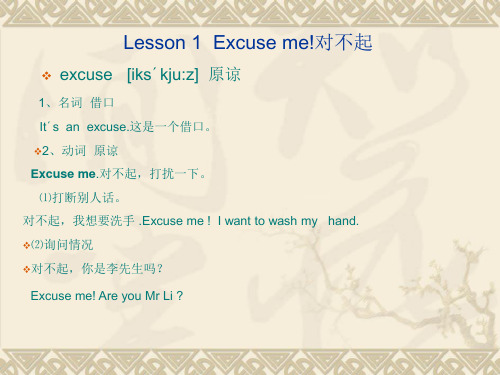
前元音:[i:] [i] [e] [æ ]
❖ [i:]-----长元音,舌头前部抬的最高,牙齿近乎 全合,舌尖抵下齿,嘴唇像两旁伸
❖
开,呈扁平型,做微笑状。
e -----me he we
ee-----see bee green need
ea-----tea eat seat lead
ie -----believe grief
❖前元音小结: 英语中有四个前元音,即:[i:] [i] [e] [æ ]
发前原因时必须注意:
①舌尖要抵住下齿。
②舌前部向硬颚部分抬起。
③双唇不要收圆,发[i:] [i] [e] 时双唇平展, 发[æ ]时口型要张大,扁唇。 ④唇形舌位保持不变,否则就要发成双元音。
ei -----receive
[i]-----短元音,舌尖抵下齿,嘴唇扁平分开,牙床也可以开得稍大一些比[i:]稍 宽,比[e]窄 i -----little sit ship listen live
❖y---many any happy twenty
❖e—delicious decide
前元音:[i:] [i] [e] [æ ]
练习题:
①这是你的手提包吗? Is this your handbag?
不,它不是。
No,it isn’t.
②This is my coat.(改成一般疑问句)
Is this your coat? ③your , is , pencil , that (?)连词成句。
Is that your pencil ?
❖ [e] 短元音,舌尖抵下齿,舌前部稍抬起,舌后接近硬颚。 ❖e-----pen ten beg egg net
ea---bread heaven
新概念1 lesson 1
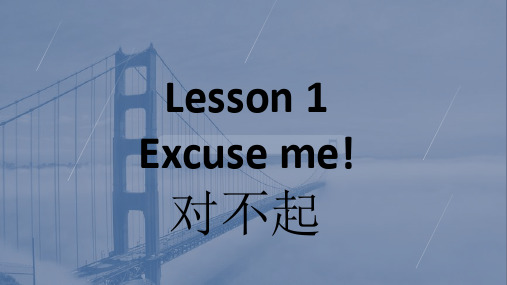
形容词性物主代词:表示一种所属关系。
对应汉语里面的“我的”“我们的”“你的”“你 们的”“ta的”“ta们的”
使用形容词性物主代词
你的短裙: your skirt 我的钢笔: my pen
Is this your handbag?
指示代词this:这,这里 th: [ð] 句型This is... :这是... e.g. This is a car. 这是一辆小汽车。
a lot: 非常地,十分地
Review
1. Excuse & sorry
2. handbag(失去爆破)
3. 人称代词主格,宾格,形容词性物主代词
主格
宾格
形容词性物主代词
I
me
my
we
us
our
you
you
your
he
him
his
she
her
her
it
it
its
they
them
their
4. This is.../ Is this...?
Is this your...? 这是你的...?
pen 钢笔 pencil 铅笔 book 书 watch 手表
dress 连衣裙 car 小汽车 house 二人称:you 第三人称:
he,she,it,they
宾格 me, us you
him,her,it,them
e.g. Glad to meet you.
ɡlad:adj.高兴的 [ɡlæd] Glad to [d] [t]失去爆破
pardon
int. interjection: 感叹词
int.原谅,请 常用在以下情况中: 再说一遍 有人跟你说话,你没
新概念英语一册 第一课 lesson1Excuse meppt课件

.
变一般疑问句步骤
一提:
找出句子中的be动词:am / is / are,把它们提到句首。
This is a book.-- is This a book.
二变:
改变句首字母的大小写。 is This a book-- Is this a book.
三问号:
注意人称变化: my/our变成your I/we变成you
Lesson1
Excuse me!
.
Greetings
.
Listening听力
第一遍,听听看,你能听到哪些单词?
.
New words and expressions生词和短语
• excuse [ik'skju:z] v. 原谅
• me [mi:, 弱mi] pron.我(宾格)
• yes [yes] adv. 是的
.
重点句型
.
Is this your handbag?
一般疑问句
• 含义:疑问句的一种,用Yes或No来 回答的句子。读升调。
• 结构:Be动词+主语+其它
Is it your car?
• 肯定回答:Yes,主语+be动词. • 否定回答:No,主语+be动词+not.
Yes, it is. No, it is not.
What's your name? --- Pardon? --- _W__h_a_t'_s_y_o_u_r__n_a_m_e_?_
.
Excuse me! Yes? Is this your handbag? Pardon? Is this your handbag? Yes, it is. Thank you very much.
(完整版)新概念第一册第一课教案

新概念英语第一册第一课教案LESSON 1 Excuse me!对不起!人称复数they them their theirs※每学完一个代词,就在上表中打钩,并标上汉语。
3、主格和宾格的区别:我打你。
I beat you. 你打我。
You beat me.主格是做主语的代词形式,即在句首、动词之前,是施加这个动作的人。
宾格是做宾语的代词形式,即在句尾、动词之后,是承受这个动作的人。
4、Yes的语调:Yes? ↗用升调,表示疑问、询问,译为:嗯?怎么了?什么事?Yes. ↘用降调,表示肯定、认可,译为:是的。
对的。
没错。
【Action】问学生你是谁。
-Excuse me. -Yes?-Are you Lucy? -Yes.5、指示代词:近指远指单数this that复数these those【Action】练习四个手势。
随便指东西,判断应该用哪个指示代词。
6、代词与be动词的使用搭配及其缩写形式:(1)人称代词与be动词的使用搭配(2)指示代词与be动词的使用搭配(3)缩写形式:I am = I’m;You are = You’reHe is = He’s;She is = She’s;It is = It’sWe are = We’re;You are = You’re;They are = They’reTom is = Tom’s;Mary is = Mary’s7、Pardon? ↗(※注意:一般疑问句要用升调。
)(用于听不清楚别人说什么,要求对方再说一次)= I beg your pardon? = What did yousay? Can you say it again, please?【Action】问学生要个东西。
-Sam, can I borrow your note, please? -Pardon?8、第二次问Is this your handbag? 的时候用了降调,是为了表示强调。
新概念英语1册 课文 完整版
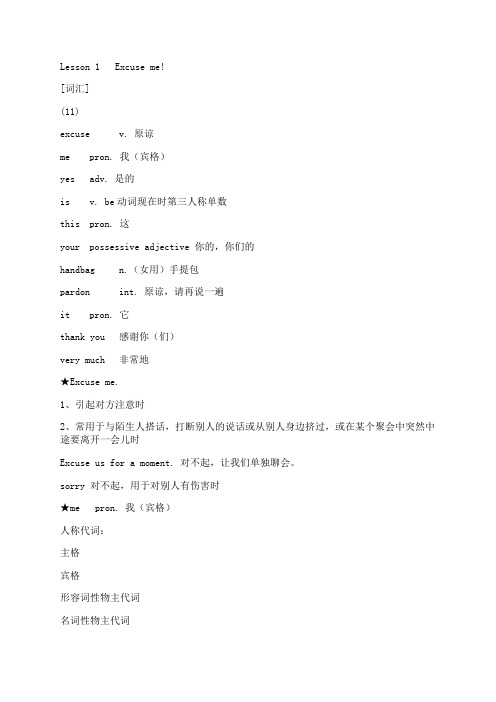
Lesson 1 Excuse meexcuse v. 原谅me pron. 我(宾格)yes adv. 是的is v. be动词现在时第三人称单数this pron. 这your possessive adjective 你的,你们的handbag n.(女用)手提包pardon int. 原谅,请再说一遍it pron. 它thank you 感谢你(们)very much 非常地★Excuse me.1、引起对方注意时2、常用于与陌生人搭话,打断别人的说话或从别人身边挤过,或在某个聚会中突然中途要离开一会儿时Excuse us for a moment. 对不起,让我们单独聊会。
sorry 对不起,用于对别人有伤害时★me pron. 我(宾格)人称代词:主格宾格形容词性物主代词名词性物主代词Imemyminehehimhishissheherherhersitititsitsyouyouyouryours主格:用在句首,作主语宾格:在动词、介词之后形容词性的物主代词:不能单独使用名词性物主代词:只能单独使用★is v. be动词现在时第三人称单数be动词:am、is、areI amshe/ he/ it isyou/ we/ they are★pardon int. 原谅,请再说一遍Pardon?/ I beg your pardon. 请求对方把刚才讲过的话重复一遍。
[语法]含有be动词的陈述句、否定句和一般疑问句含有be动词的任何句子,否定句就是在be动词后面加not;如果变一般疑问句,就把be动词提前到句子的前面。
[课文]Excuse me.Yes?Is this your handbag?Pardon?Is this your handbag?Yes, it is.Thank you very much.Lesson 2 Is this your…?[词汇](10)pen n.钢笔pencil n.铅笔book n.书watch n.手表coat n.上衣,外衣dress n.连衣裙skirt n.裙子shirt n.衬衣car n.小汽车house n.房子★dress① n. 连衣裙;套裙② n. 服装,衣服casual dress 便服evening dress 晚礼服★house n.房子house 房子,一般指独立的院落,更具体的指房子的建筑,结构family 侧重家庭的成员There are four people in my family. 在我家里有四口人。
Lesson1Excuseme!(课件)新概念英语第一册
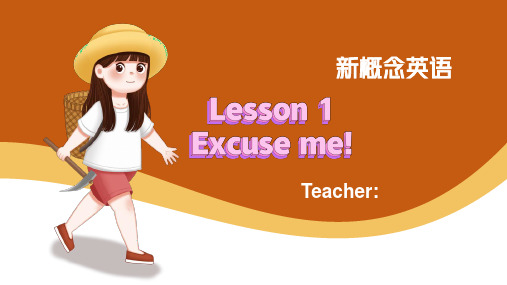
全句为I beg your pardon.意思是请求对方把刚才讲过的话重复一遍 。
Pardon
New words and expressions: excuse v. 原谅 handbag n. (女用)手提包 pardon int. 原谅,请再说一遍 thank you 感谢你(们) very much 非常地
新概念英语
Teacher:
01 New words and expressions 02 Listening 03 Notes on the text
excuse /ɪkˈskjuːs/ v. 原谅 me /miː/ pron. 我(宾格) yes /jes/ adv. 是的 is /ɪz/v. 是 be动词现在时第三人称单数 this /ðɪs/ pron.这 your /jɔ :/ 你的,你们的 handbag /'hændbæg/ n. (女用)手提包 pardon /'pa:dn/ int.原谅,请再说一遍 it /ɪt/ pron.它 thank you very much /ˈθæŋk juː/ /ˈveri mʌtʃ//非常感谢你(们)
➢ Find it
Thank youaFra bibliotekntyour
excuse
mother
handbag
pardon sorry this
Listening to the tape then answer this question: Whose handbag is it
The woman’s handbag.
Thank You
Conversations: A: Excuse me! B: Yes A: Is this your handbag B: Pardon A: Is this your handbag B: Yes, it is. B:Thank you very much.
新概念一第一课Lesson1Excuse me课文+详细注解
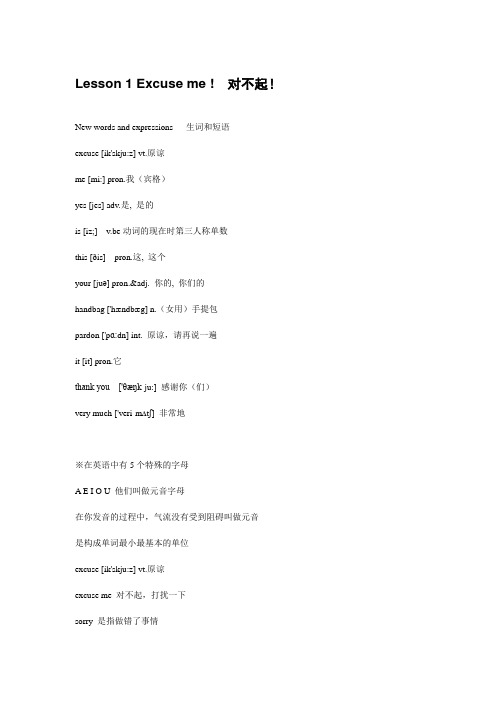
Lesson 1 Excuse me ! 对不起!New words and expressions 生词和短语excuse [ik'skju:z] vt.原谅me [mi:] pron.我(宾格)yes [jes] adv.是, 是的is [iz;] v.be动词的现在时第三人称单数this [ðis] pron.这, 这个your [juə] pron.&adj. 你的, 你们的handbag ['hændbæg] n.(女用)手提包pardon ['pɑ:dn] int. 原谅,请再说一遍it [it] pron.它thank you ['θæŋk-ju:] 感谢你(们)very much ['veri-mʌtʃ] 非常地※在英语中有5个特殊的字母A E I O U 他们叫做元音字母在你发音的过程中,气流没有受到阻碍叫做元音是构成单词最小最基本的单位excuse [ik'skju:z] vt.原谅excuse me 对不起,打扰一下sorry 是指做错了事情而其他的场合,为了引起话题,想询问,或者让路,用excuse me excuse n.借口, 理由, 饶恕, 致歉Eg:It is the excuse for him to eat the apple.这就是他吃苹果的借口Please excuse me for opening the door .请原谅我把门打开了。
介词后面要+doing(for about)me [mi:] pron.我(宾格)e的前面没有其他元音字母的时候,e发本身音放在动词和介词的后面做宾语Look after me 照顾我Can you help me? 你能帮助我么?Let me help you 让我帮助你吧yes [jes] adv.是, 是的他的反义词是noy常见的发音有3种fry[frai] sorry['sɔri]Are you a teacher ?你是一名老师么?Yes,I am 是的,我是No,I am not 不,我不是Aren’t you a teacher ?你不是一名老师么?Yes,I am 是的,我是No,I am not 不,我不是Aren’t you a te acher ?你不是一名老师么?No. i am a doctor.不。
课件新概念第一册 Lesson 1 Excuse me!对不起

前元音:[i:] [i] [e] [æ ]
❖ [i:]-----长元音,舌头前部抬的最高,牙齿近乎 全合,舌尖抵下齿,嘴唇像两旁伸
❖
开,呈扁平型,做微笑状。
e -----me he we
ee-----see bee green need
ea-----tea eat seat lead
ie -----believe grief
❖前元音小结: 英语中有四个前元音,即:[i:] [i] [e] [æ ]
发前原因时必须注意:
①舌尖要抵住下齿。
②舌前部向硬颚部分抬起。
③双唇不要收圆,发[i:] [i] [e] 时双唇平展, 发[æ ]时口型要张大,扁唇。 ④唇形舌位保持不变,否则就要发成双元音。
Lesson 1 Excuse me!对不起
❖ excuse [iks´kju:z] 原谅
1、名词 借口 It´s an excuse.这是一个借口。 ❖2、动词 原谅 Excuse me.对不起,打扰一下。 ⑴打断别人话。 对不起,我想要洗手 .Excuse me ! I want to wash my hand. ❖⑵询问情况 ❖对不起,你是李先生吗?
I love you very much.我非常地爱你。
Lesson 1 Excuse me!对不起
❖ Lesson 1 ❖ 1 excuse [ik'skju:z] v.原谅 ❖ 2 me [mi:, mi] pron.我(宾格) ❖ 3 yes [jes] ad.是的 ❖ 4 is [iz, s, z, əz] v.be动词现在时第三人称单数 ❖ 5 this [ðis] pron.这 ❖ 6 your [jə:, jɔ:, jər, jɔ:r] 你的,你们的 ❖ 7 handbag ['hæ ndbæ g] n.(女用)手提包 ❖ 8 pardon ['pɑ:dən] int.原谅,请再说一遍 ❖ 9 it [it] pron.它 ❖ 10 thank you 感谢你(们) ❖ 11 very much 非常地
新概念英语(一)Excuse me
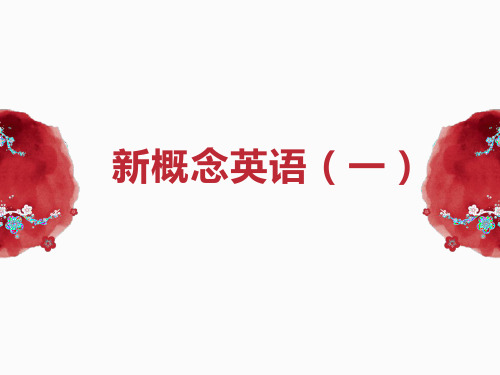
• 注意2个变 1.遇 some变any 2、遇第一人称,变成第二 人称(be动词随主语变)
• 1.It is a ruler. It isn’t a ruler. Is it a ruler ? Yes , it is . No, it isn’t.
2. I am a teacher. I am not a teacher. Are you a teacher? Yes , I am . No. I’m not
• 口诀:一找二提三问号
• 一找:找动词,动词一般跟在主语后面,排在第二位
• 二提:提前, 把动词提到句子最前面
• 态动词)提情 情态动词(can、could、must)
• 无情无be找助动(助动词) 助动词(do 、did、does)
• 三问号(把句末的句号变成问号)
Lesson 1 Excuse me (单词)
• 1 excuse [ik'skju:z] v.原谅 • 2 me [mi:, mi] pron.我(宾格) • 3 yes [jes] ad.是的 • 4 is [iz, s, z, əz] v.be 动词现在时第三人称单数 • 5 this [ðis] pron. 这 • 6 your [ jɔ:, jɔ:r] 你的, 你们的 • 7 handbag ['hændbæg] n.(女用)手提包 • 8 pardon ['pɑ:dən] int.原谅, 请再说一遍 • 9 it [it] pron.它 • 10 thank you 感谢你(们) • 11 very much 非常地
• I’m sorry that I can’t come.
•2.Yes? 什么事?
• 语气上扬,对他人的搭讪表示疑问。嗯?什么事?
新概念英语第一册 lesson1(excuse me)and2主谓宾

Lesson1 Excuse me!1.excuse me 与Sorry 的辨析excuse me: “希望引起对方注意”,例如:问路,插话,走开或者表示异议。
Eg. Excuse me, where is the nearest post office?Excuse me, I need to answer the call.Sorry “常用在表达已经做过的或者发生过的事情。
”Eg. Sorry, I’m late. May I come in?或者用于表达遗憾或者不满足别人的要求而感到抱歉。
Eg. A: My grandfather passed away yesterday.B: I’m sorry to hear that.2.物主代词的区别及应用Practice:Eg. 1.我爱妈妈。
___________________________. 他爱他的爸爸。
___________________________.我爱我的妈妈。
___________________________. 他的爸爸爱他。
___________________________.我的妈妈爱我。
___________________________. 她的妈妈爱她。
___________________________.3.关键句型:this is ...(这是...) 一般疑问句:Is this...? Yes, it is./No, it isn’t.这是我的钢笔/铅笔。
___________________________. ___________________________.这是他的书/手表。
___________________________. ___________________________.这是我的上衣/裙子。
___________________________. ___________________________.这是她的连衣裙。
新概念英语1公开课Unit1Excuse
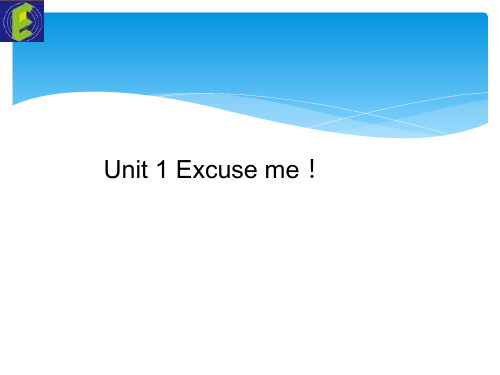
• This is a book. • →Is this a book?
• I am a student. • → Are you a student?
小练习
• 1. This is my school. • →Is this your school?
3. 用于打喷嚏或谈话过程中清嗓子时
A:(after a sneeze)Excuse me! B: Bless you!
Yes?↑
“什么事?” “怎么了?” “干吗?”
Yes. ↓ “是的。”
Is this your handbag?
一般疑问句(★★★)
特点: 用Yes/No可以回答的疑问句
பைடு நூலகம்
(带be动词的)肯定句 变一般疑问句的步骤:
Thank you!
人有了知识,就会具备各种分析能力, 明辨是非的能力。 所以我们要勤恳读书,广泛阅读, 古人说“书中自有黄金屋。 ”通过阅读科技书籍,我们能丰富知识, 培养逻辑思维能力; 通过阅读文学作品,我们能提高文学鉴赏水平, 培养文学情趣; 通过阅读报刊,我们能增长见识,扩大自己的知识面。 有许多书籍还能培养我们的道德情操, 给我们巨大的精神力量, 鼓舞我们前进。
Pardon?
• 没听清楚对方的话,希望对方 再说一遍时
• I beg your pardon? • Pardon me?
Yes, it is.
• Is this/that ...? • Yes, it is. (肯定回答) • No,it isn't.(否定回答)
• Are these/those ...?
LESSON-1新概念英语EXCUSE-ME
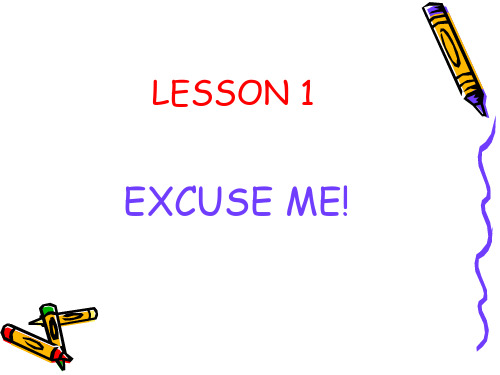
What’s this?
It is a handbag/pen/pencil/desk?
Is it a handbag? Yes, it is./No, it isn’t. Is it your handbag? Yes, it is. Pardon. Is it your handbag? Yes, it is. Here you are. Thank you very much.
Practice
some dialogues.
Thank YOU!!
Wish you a happy day!
LESSON 1
EXCUSE ME!
Excuse me 和 I’m sorry
-Excuse me是抱歉,打扰了的意思, 比如,你想向别人询问时间,问路, 或者打断别人的话时,或者打喷嚏时
表示不好意思,等等 -I am sorry 是真的做错了事,表示
道歉 应用:比如,你迟到了,I'm sorry
CAN YOU ?
• Excuse me, what time is it ?
• Excuse me, can I go out for a few minutes?
• Excuse me, can you help me carry the box?
• I’m sorry, I’m late.
• I’m sorry to hear the bad news.
I'm late. 或者你听到什么不好的消息I am sorry to hear about your illness.
Excuse me 和 I’m sorry的 练习
(完整版)新概念英语第一册课文版(最新整理)
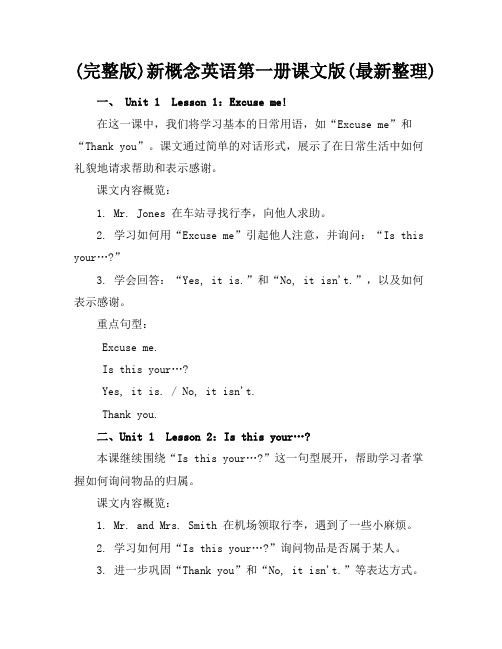
(完整版)新概念英语第一册课文版(最新整理)一、 Unit 1 Lesson 1:Excuse me!在这一课中,我们将学习基本的日常用语,如“Excuse me”和“Thank you”。
课文通过简单的对话形式,展示了在日常生活中如何礼貌地请求帮助和表示感谢。
课文内容概览:1. Mr. Jones 在车站寻找行李,向他人求助。
2. 学习如何用“Excuse me”引起他人注意,并询问:“Is this your…?”3. 学会回答:“Yes, it is.”和“No, it isn't.”,以及如何表示感谢。
重点句型:Excuse me.Is this your…?Yes, it is. / No, it isn't.Thank you.二、Unit 1 Lesson 2:Is this your…?本课继续围绕“Is this your…?”这一句型展开,帮助学习者掌握如何询问物品的归属。
课文内容概览:1. Mr. and Mrs. Smith 在机场领取行李,遇到了一些小麻烦。
2. 学习如何用“Is this your…?”询问物品是否属于某人。
3. 进一步巩固“Thank you”和“No, it isn't.”等表达方式。
重点句型:Is this your…?Yes, it is. / No, it isn't.Thank you.三、Unit 1 Lesson 3:Sorry, sir.在这一课中,我们将学习如何在道歉时使用“Sorry”和“Sir”。
课文内容概览:1. Mr. Brown 在餐馆吃饭,不慎将食物洒在邻桌客人身上。
2. 学习如何用“Sorry, sir.”表达歉意,并请求对方原谅。
3. 学会回答:“That's all right.”表示不在意。
重点句型:Sorry, sir.That's all right.四、Unit 1 Lesson 4:Unite 1 Review在这一课,我们将回顾前三个课时的内容,并通过练习加深对所学知识的理解和运用。
新概念一第一课课文
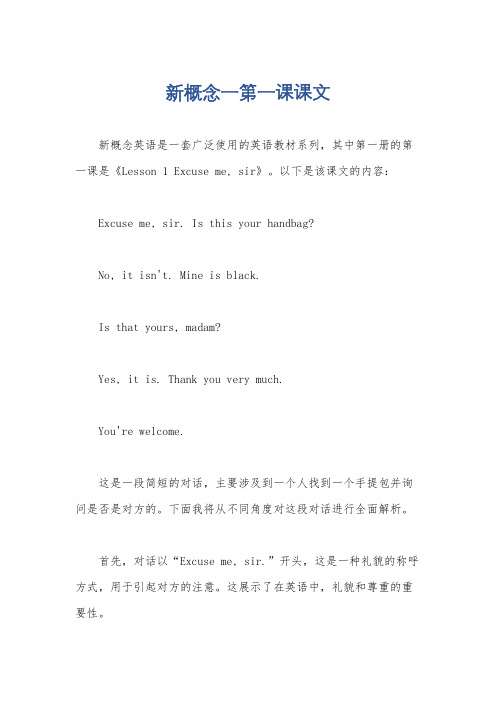
新概念一第一课课文新概念英语是一套广泛使用的英语教材系列,其中第一册的第一课是《Lesson 1 Excuse me, sir》。
以下是该课文的内容:Excuse me, sir. Is this your handbag?No, it isn't. Mine is black.Is that yours, madam?Yes, it is. Thank you very much.You're welcome.这是一段简短的对话,主要涉及到一个人找到一个手提包并询问是否是对方的。
下面我将从不同角度对这段对话进行全面解析。
首先,对话以“Excuse me, sir.”开头,这是一种礼貌的称呼方式,用于引起对方的注意。
这展示了在英语中,礼貌和尊重的重要性。
接着,对话中的第一个问题是“Is this your handbag?”,通过这个问题,询问者想要确认这个手提包是否属于对方。
这个问题展示了一种常见的交际方式,即通过询问来获取信息。
对方回答说“No, it isn't. Mine is black.”,这表明这个手提包不属于对方,并提到了自己的手提包是黑色的。
这个回答展示了一种否定的回应方式,并提供了额外的信息。
然后,询问者继续询问“Is that yours, madam?”,这次询问的对象是一个女士。
这展示了在英语中,对不同性别的人使用不同的称呼方式。
女士回答说“Yes, it is. Thank you very much.”,确认这个手提包是她的,并表示感谢。
这展示了一种肯定的回应方式,并表达了感激之情。
最后,询问者回答“You're welcome.”,表示对女士的感谢。
这展示了一种常见的礼貌回应方式。
总结来说,这段对话展示了一种常见的交际场景,即在发现一个物品时,通过询问确认物品的归属,并进行相应的回应。
通过这段对话,我们可以学习到一些常用的英语表达方式和礼貌用语。
- 1、下载文档前请自行甄别文档内容的完整性,平台不提供额外的编辑、内容补充、找答案等附加服务。
- 2、"仅部分预览"的文档,不可在线预览部分如存在完整性等问题,可反馈申请退款(可完整预览的文档不适用该条件!)。
- 3、如文档侵犯您的权益,请联系客服反馈,我们会尽快为您处理(人工客服工作时间:9:00-18:30)。
Karen
Unit 1 Excuse me!
各种包
handbag
schoolbag wallet
briefcase
purse
Excuse me!
1. 向陌生人问路或问事时 Excuse me, where is VOIEE? 2. 用于打断别人的谈话,或想要插话时 Excuse me,
祈使句 感叹句 If条件句 直接引语 间接引语 过去进行时 将来进行时 过去完成时 陈述句 一般过去时 there be 句型 的5大基本句型 一般将来时 一般现在时 现在完成时 现在进行时 被动语态 情态动词 不定代词 形容词比较级 状语从句 学员本期能收获的知识
中考重点语法
学习,贵在持之以恒
3. 用于打喷嚏或谈话过程中清嗓子时
A:(after a sneeze)Excuse me! B: Bless you!
Yes?↑
“什么事?” “怎么了?” “干吗?”
Yes. ↓ “是的。”
Is this your handbag?
一般疑问句(★★★)
特点: 用Yes/No可以回答的疑问句
(带be动词的)肯定句 变一般疑问句的步骤:
非常感谢! Thank you! Thanks! Thanks a lot! Many thanks!
不用谢!
• • • • You're welcome. That's all right. Not at all. It's a pleasure.
新概念英语1:我们将学到什么
• 1013个单词(895个常用词+ 79个人名+39个地名) • 1087个句子 • 143个短语
Yes, it is.
• Is this/that ...? • Yes, it is. (肯定回答) • No,it isn't.(否定回答)
• Are these/those ...?
• Yes, they are.(肯定回答) • No, they aren't.(否定回答)
Thank you very much!
英语学习的特点
• 英语是一门语言,是一个 长期积累的过程。
给家长的忠告和建议
1.连续性
没有量的积累,就不会有质的飞跃。 2. 尊重并鼓励孩子
经常赞美孩子,而不是打击他/她。
我们的教学理念
培养兴趣 → 树立自信 → 养成良好的学习习惯 → 学好英语
Thank you!
这是... ...吗? Is this ... ? 那是... ...吗? Is that ...? 这些是... ...吗? Are these ...? 那些是... ...吗? Are those ...?
Pardon?
• 没听清楚对方的话,希望对方 再说一遍时
• I beg your pardon? • Pardon me?
1. be提前,首字母大写 2. 主语移到be后面,首字母大写变小写 3. 其它部分一般情况下不变 4. 句尾用问号
• This is a book. • →Is this a book? • I am a student. • → Are you a student?
小练习
• 1. This is my school. • →Is this your school? • 2. That is my sister. • →Is that your sister?
